Safety Guidelines
We will always make every attempt to be safe and not put anyone at risk. However paddling has inherent risks and it is not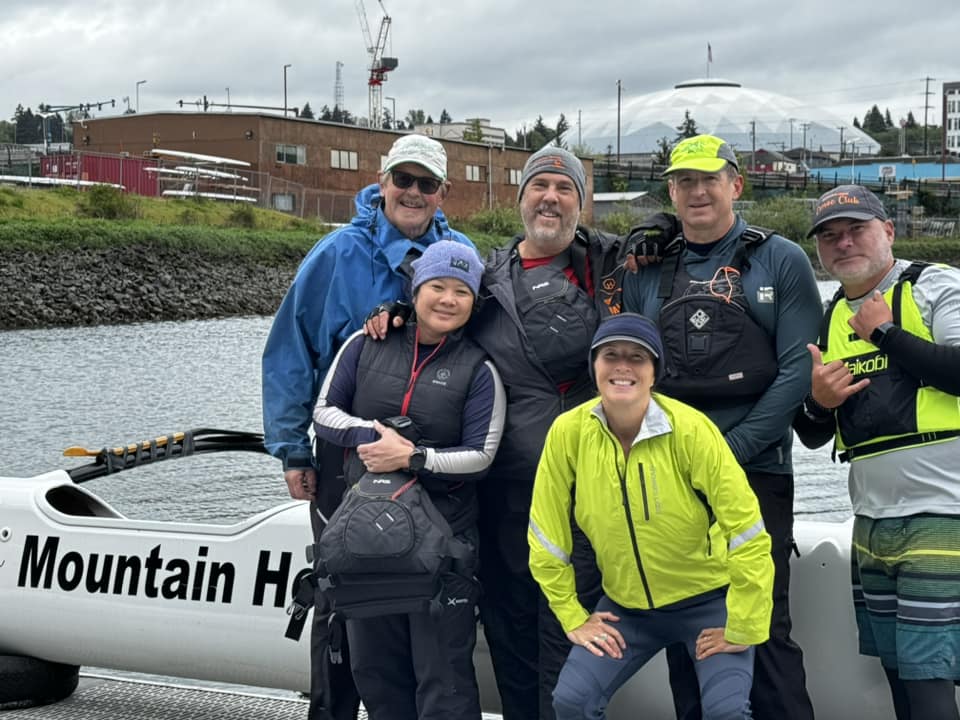 possible to guarantee your safety. There is no "formula" for knowing when it is safe or unsafe to paddle. It is always a judgment call and safety levels will always be different for different people. While safety in paddling will always be number one, the bottom line is that "we paddle at our own risk". Everyone knows their own comfort level and all should feel comfortable in not going on the water when they don't want to. We have called off practices due to weather conditions but it has not been necessary very often.
possible to guarantee your safety. There is no "formula" for knowing when it is safe or unsafe to paddle. It is always a judgment call and safety levels will always be different for different people. While safety in paddling will always be number one, the bottom line is that "we paddle at our own risk". Everyone knows their own comfort level and all should feel comfortable in not going on the water when they don't want to. We have called off practices due to weather conditions but it has not been necessary very often.
All members are expected to know basic canoeing safety practices. Each boat shall have at least one Coast Guard approved personal floatation device for every person on the boat, a whistle or other noise making device, and a stern light (white, set in non-flashing mode), and bow red/green light per Coast Guard regulations for paddling in reduced light conditions. It is strongly recommended that there be at least one extra paddle on each OC6.
Canoe Safety for practice Safety is the individual paddlers responsibility.
Each paddler is responsible to make sure that the boat they are in has the required equipment listed above (i.e., enough PFDs for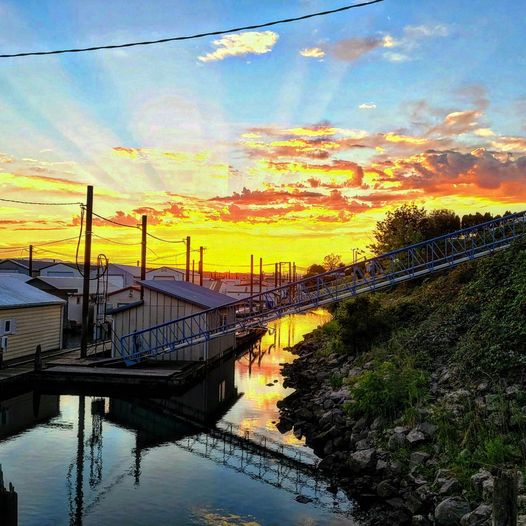 everyone in the boat no matter the weather or water conditions or how experienced paddlers may be, a whistle, and a working light when needed). Each paddler is responsible for putting a PFD under their seat before the boat leaves the dock. Each paddler is responsible to check to see that the boat rigging is tight/correct and the canoe is prepared for conditions it will face on the water. Every canoe must have one five-gallon bucket looped into the hull upfront of Seat 5 by a quick release. Each canoe must have two small bailers before leaving the dock. During the winter months when canoes are skirted each small bailer must have a rubber tied securely to its handle and looped with a quick release at Seat 3 and Seat 4. In the dark or cold these bailers will save your life. They must be located easily. People should know your fellow paddlers skills and know the ability of the boat to contend with conditions they might encounter. The crew must be able to self-rescue in the event of capsize. Safe operation of the canoe is each paddler’s responsibility. Safety is each paddler’s responsibility. Individuals are responsible for themselves.
everyone in the boat no matter the weather or water conditions or how experienced paddlers may be, a whistle, and a working light when needed). Each paddler is responsible for putting a PFD under their seat before the boat leaves the dock. Each paddler is responsible to check to see that the boat rigging is tight/correct and the canoe is prepared for conditions it will face on the water. Every canoe must have one five-gallon bucket looped into the hull upfront of Seat 5 by a quick release. Each canoe must have two small bailers before leaving the dock. During the winter months when canoes are skirted each small bailer must have a rubber tied securely to its handle and looped with a quick release at Seat 3 and Seat 4. In the dark or cold these bailers will save your life. They must be located easily. People should know your fellow paddlers skills and know the ability of the boat to contend with conditions they might encounter. The crew must be able to self-rescue in the event of capsize. Safe operation of the canoe is each paddler’s responsibility. Safety is each paddler’s responsibility. Individuals are responsible for themselves.
Personal Flotation Devices (PFDs)
Life jackets (PFDs) are highly recommended during the winter months. One PFD for every paddler on a canoe is mandatory per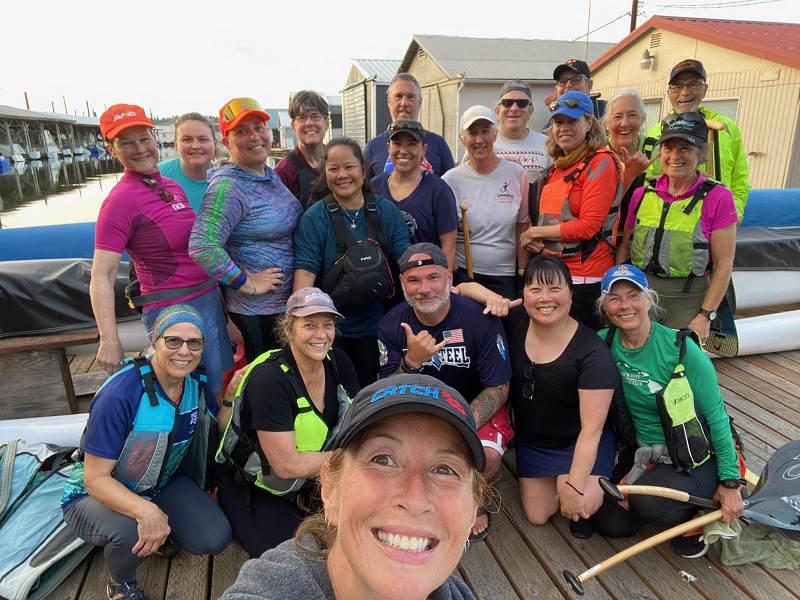 Coast Guard regulations. If you choose not to wear a PFD (which Mountain Home does not recommend) please make sure to place a PFD under your seat on the canoe before the canoe leaves the dock. The Club provides Coast Guard approved PFDs or you may opt to bring your own paddling PFD. If you are an inexperienced swimmer, wearing a PFD every time you are on the boat should be considered and Mountain Home feels it mandatory.
Coast Guard regulations. If you choose not to wear a PFD (which Mountain Home does not recommend) please make sure to place a PFD under your seat on the canoe before the canoe leaves the dock. The Club provides Coast Guard approved PFDs or you may opt to bring your own paddling PFD. If you are an inexperienced swimmer, wearing a PFD every time you are on the boat should be considered and Mountain Home feels it mandatory.
The Huli - What you MUST know
The Art of Righting a Polynesian Canoe If and when you do huli pau (capsize), follow these steps and you should be back up and paddling in no time.
- Count heads - Steersperson take control and have each paddler count off. If you come up one number short, start searching under va'a (canoe).
Once ALL paddlers are accounted for each seat takes on a role to right the canoe. Your roll is imperative to the safety of others. Take it seriously and know all positions before you get into a canoe so that you can assist where needed if someone cannot preform.
- Seat 1 collects paddles before they drift away. You need paddles to survive the huli and get back to shore safely. Also any
 items left in canoe and not tied down, water bottles, buckets, etc. If it is cold and dark do NOT worry about these items aside from the paddles.
items left in canoe and not tied down, water bottles, buckets, etc. If it is cold and dark do NOT worry about these items aside from the paddles.
- Seat 2 and 4 stand on iakus underwater to give yourself height and swing your leg over the hull now sticking out of the water. Straddle the hull like a horse and await for everyone to be ready.
- Seat 3 swim to ama and be ready to push it up out of the water to help 2 and 4 pull it over.
- Seat 5 position yourself towards the back of the boat so that you are out of the way when the ama comes down.
- Seat 6 is calling the shots and keeping everyone on track
- When everyone is ready Seat 3 push the ama and Seat 2 & 4 pull the ama over by leaning down and grabbing the iakus.
- When the ama comes down Seat 5 swim over and hold ama down if necessary.
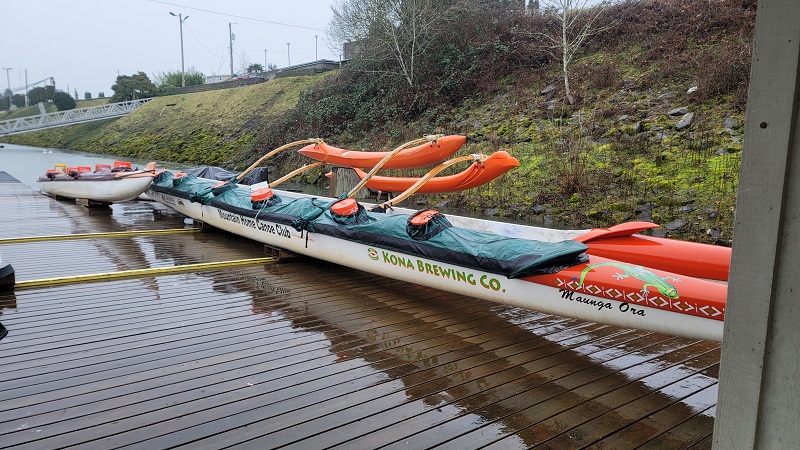
- Seat 4 get into canoe and use large bucket to bail as fast as possible.
- Other paddlers bail from outside of the boat.
- When water is lower Seat 3 get in and continue to bail quickly.
- All paddlers continue bailing and entering canoe until canoe is empty of water.
- Check that all PFD's are in the canoe with paddlers and paddles and continue to safety.
Safety on Small Boats
When Can I use a club small boat? After you become a member you MUST complete a 'huli' drill (recovering from a capsized boat)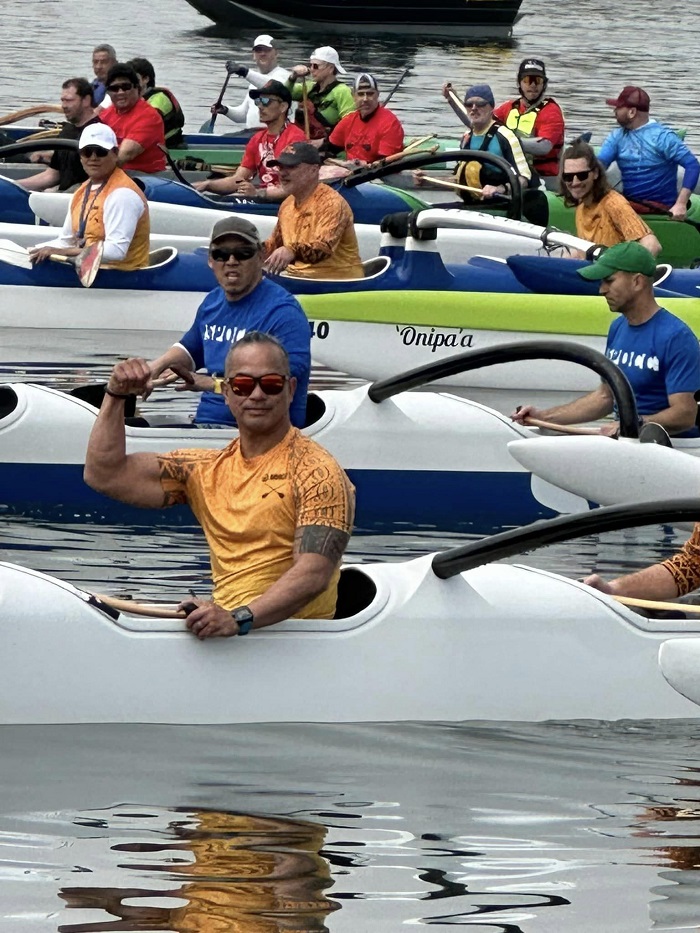 with a designated Mountain Home member. Please ask the board who these people are. As on all of our canoes, you are required to take a PFD, whistle, and bailer tied into each OC1/2. Please also take lights if paddling after sundown or before sunrise. Remember there is "safety in numbers." When paddling with others, try to stay together and be aware of your fellow paddlers. Stop and assist troubled paddlers. Make sure that everyone in your group is off the water safely before you get off the water. Expectation when you are on small boats: Safety is #1! Write down on the marker board what time you leave the dock and which direction you are headed; up or down river.
with a designated Mountain Home member. Please ask the board who these people are. As on all of our canoes, you are required to take a PFD, whistle, and bailer tied into each OC1/2. Please also take lights if paddling after sundown or before sunrise. Remember there is "safety in numbers." When paddling with others, try to stay together and be aware of your fellow paddlers. Stop and assist troubled paddlers. Make sure that everyone in your group is off the water safely before you get off the water. Expectation when you are on small boats: Safety is #1! Write down on the marker board what time you leave the dock and which direction you are headed; up or down river.
Sign a Waiver:
You will need to sign two waivers before you begin to paddle with Mountain Home. If you are not a member of USACK (USA Canoe/Kayak) Federation you will need to sign an USACK waiver and pay $10 upon signature and before you paddle with us. Membership in USACK provides accident and personal liability insurance and is mandatory of all members of MHCC and PNW-ORCA, our regional association. Personal Flotation Devices are highly recommended during the winter months. Please protect yourself and help us to stay compliant by signing the waiver located in the boathouse. Additionally you need to sign a Mountain Home Canoe Club waiver, also located in the boathouse
What if I can't swim?
This is a good question and one we take seriously. During every practice, our paddlers make every effort to be safe on the water; however, sometimes situations could land you in the water at any time of the year. If you cannot swim, you should wear a life vest AT ALL TIMES and you should consider learning basic swimming skills before you come out to paddle. Not all members are highly skilled swimmers, however you must be comfortable enough in the water to assist in righting the canoe in the event of a capsize (or huli) and climbing back into the boat. The water is not something to take lightly and taking responsibility for yourself and those around you is of the utmost importance. If you cannot swim you are encouraged to learn how to tread water efficiently before coming out to paddle and to always wear a life vest during practice or race events.
however, sometimes situations could land you in the water at any time of the year. If you cannot swim, you should wear a life vest AT ALL TIMES and you should consider learning basic swimming skills before you come out to paddle. Not all members are highly skilled swimmers, however you must be comfortable enough in the water to assist in righting the canoe in the event of a capsize (or huli) and climbing back into the boat. The water is not something to take lightly and taking responsibility for yourself and those around you is of the utmost importance. If you cannot swim you are encouraged to learn how to tread water efficiently before coming out to paddle and to always wear a life vest during practice or race events.
Preparation
When you first arrive on the dock, find the USACK and MHCC waivers to sign. You will see several people standing around chitchatting. Don’t be bashful. Introduce yourself to whomever is near. There will be some scurrying about as paddlers prepare the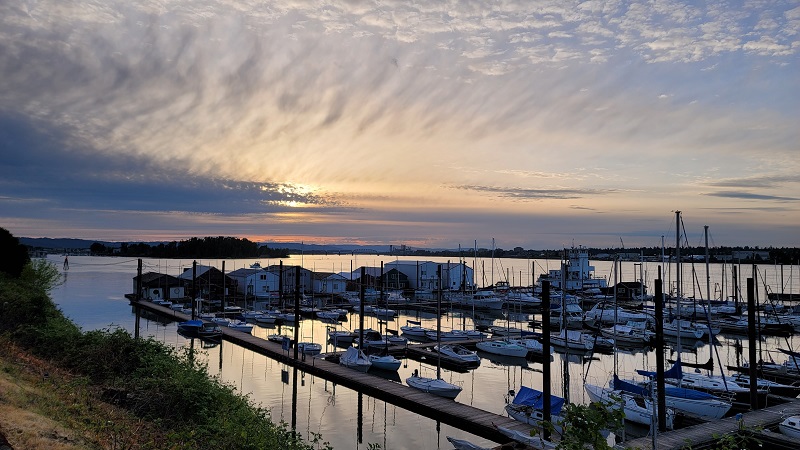 OC6s for launching (bailing out rainwater and putting PFDs in each canoe). Once enough canoes are in the water, everyone jumps into a boat following the coaches’ instructions but you MUST sign a waiver before you leave on a canoe.
OC6s for launching (bailing out rainwater and putting PFDs in each canoe). Once enough canoes are in the water, everyone jumps into a boat following the coaches’ instructions but you MUST sign a waiver before you leave on a canoe.
Dress
In the cold winter months, wear layers as it may be windy, wet, and cold. You will definitely get warmer once you start paddling, but starting out warm is important. You can always peel off extra clothes so it is better to over dress. Try an under layer of some polyester fabric. Avoid cotton because it soaks up the water and stays cold. Your outer layer should be water and wind resistant. You will get wet, primarily your upper body, unless it is raining, then you may get wet all over. It’s a water sport! Neoprene gloves are great to keep your hands warm, as they will be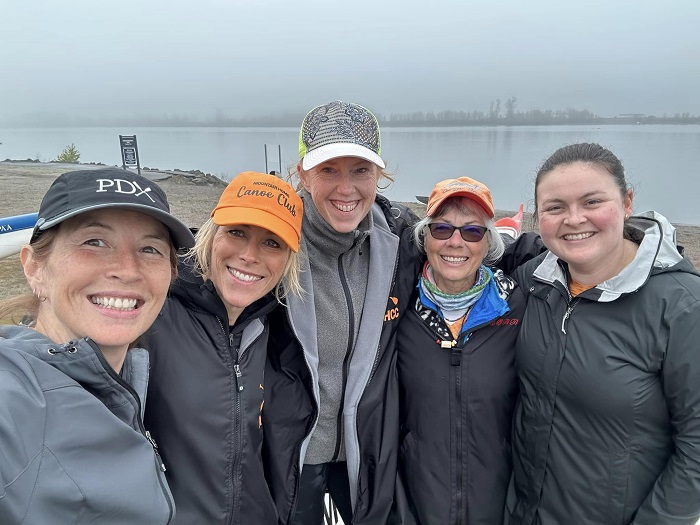 coming into contact with the cold water. For shoes, try neoprene booties or old athletic shoes with fleece or wool socks. Bring extra dry clothes to change into after practice. When the weather warms, shorts, tank tops, and sandals are fine. Many go barefoot in the canoes, as it is tradition. Be prepared for any weather condition our great Northwest provides.
coming into contact with the cold water. For shoes, try neoprene booties or old athletic shoes with fleece or wool socks. Bring extra dry clothes to change into after practice. When the weather warms, shorts, tank tops, and sandals are fine. Many go barefoot in the canoes, as it is tradition. Be prepared for any weather condition our great Northwest provides.
Hydration
Carrying your own water is essential. A water bottle works, but most paddlers prefer hydration packs. The fanny kind is preferred because the back mount moves around when paddling. On longer Saturday paddles, you may want to bring along a power bar or some other quick nutrition.
Hypothermia Do’s and Don’ts
Hypothermia can be fatal
GRADUAL reheating is imperative
About Hypothermia
Normal body temperature - 98.6 Fahrenheit / 37 Celsius
Hypothermia is the excessive loss of body heat and the consequent lowering of the inner core temperature.
Victim is generally not able to notice his or her own condition.
Breathing and Heart Rate are slowed and may be very difficult to detect in severe hypothermia. Muscular weakness and drowsiness are experienced.
If no pain can be felt, serious injury can occur without the victim's noticing it.

Do NOT
Do NOT raise the victim’s feet if unconscious
Do NOT reheat the body with a hot shower, hot water bottles, or electric blankets
Remember
"Conscious" and "Mental Clarity" are two different things.
A person can be "conscious and reactive" and yet still be in hypothermic state, so the level of consciousness is not always a reliable indicator of the victim's condition. Objective opinion is extremely important.
Do
DO - calmly and quickly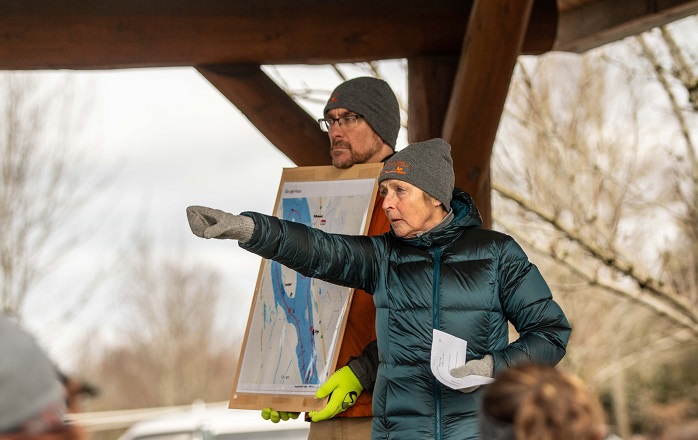
DO immediately seek medical help
DO ensure that ALL wet clothing is removed
DO place the victim between blankets or new dry layers so the body temperature can rise GRADUALLY
DO supply body-to-body contact to increase temperature
DO continue to talk and capture the victim’s alertness
DO give lukewarm sweet, non-caffeine, nonalcoholic drinks, UNLESS victim is losing consciousness, is unconscious, or is convulsing
DO quickly transport the victim to an emergency medical facility